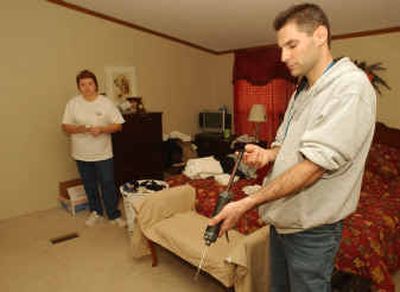Residents return after chlorine accident

GRANITEVILLE, S.C. – Dawn Smith circled her house nervously on the morning she was allowed to return.
A white flower had bloomed while she was away. The mildew that sprinkled the shady side of her house had vanished, as if someone had scrubbed it. And when Smith found her dog, a chocolate Labrador, the animal had been bleached two shades lighter.
On Jan. 6, a plume of poisonous chlorine gas moved slowly through this residential neighborhood, seeping into houses through heating vents while families waited, terrified, inside. By Saturday, 4,200 evacuated residents had been allowed to return to their homes after authorities assured them the gas had dissipated. About 1,300 people were still displaced, said Lt. Mike Frank of the Aiken County Sheriff’s Department.
But many felt strange and fearful in the familiar settings, and some hung back in their hotel rooms. “When we hear a train, we’re going to have a fear of it now. Nothing, nobody is going to take that away. You’re going to be wondering, ‘Did we live this time to die next time?’ ” said Rhonda Smith, 35, whose house is beside the tracks. “As many times as a train came by our house, I never once thought, ‘Maybe they’re carrying something that could kill us all.’ “
Nine people died and 240 were injured as a result of the crash, which occurred at 2:40 a.m. when a Norfolk Southern train carrying pressurized chlorine gas collided with a parked train. National Transportation Safety Board officials said the crash occurred because crew members on an earlier train guided their train to a side track and then failed to reset the switch, so the Norfolk Southern engineer ran into the parked train.
By the end of last week, the survivors had told their stories. Lamar Ledford, a night shift worker at Avondale Mills, described watching white patches spread across the clothes on his body while he waited for a 911 operator to tell him it was safe to leave the building. His cell phone began to corrode in his hand, he told local television crews, and he called his mother to tell her he wanted to be cremated.
Rhonda Smith described gazing out at emergency personnel whiz back and forth outside in safety suits, and waking up her children to tell them she loved them. She had no vehicle at her house, and was waiting for someone to stop by to ask if she was safe, but no one came until more than 18 hours after the crash.
“I don’t even know how to explain the feeling,” she said. “I had a washrag on my face constantly. It felt like something was sitting on your chest and it would not let up.”
Phil Napier, the fire chief, described driving to the scene of the train crash and seeing the engineer stagger out of the cloud and fall to the ground. He jerked his truck around and drove out of the cloud to save his own life. The engineer, 28-year-old Christopher Seeling, later died.
“It was just like pouring water into an ant bed, and the ants scatter,” he said. “You saw people foaming at the mouth. It’s a horror story.” But authorities who entered the “hot zone” on Friday found a peaceful, safe neighborhood, said Scott Wright, senior emergency response coordinator for the federal Centers for Disease Control and Prevention.
Chlorine corrodes copper elements in telecommunications equipment and computer chips, and can disable a 911 service under some circumstances, Wright said. It etches and pits paint, eats through sheet metal, bleaches trees and other vegetation, and turns into hydrochloric acid on contact with water or moist tissue. Humans who breathe in chlorine can suffocate because their throats swell from acid burns.
But it also dissipates quickly. When crews entered the “hot zone” on Thursday to search for pets that had been left behind, they found no unusual chlorine levels, Wright said, perhaps because chemical residue was washed into Horse Creek by a rainstorm the evening after the crash.
At a town meeting last week, public health officials warned residents that they may experience “emotional aftershocks” in the coming weeks. “What they are dealing with is the fear of the unknown,” said Gregory Smith, the medical director of the Aiken-Barnwell Mental Health Center in nearby Aiken. Scientists may tell them their homes are safe, but “folks are still afraid,” he said.